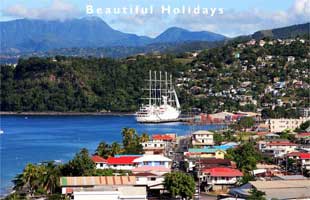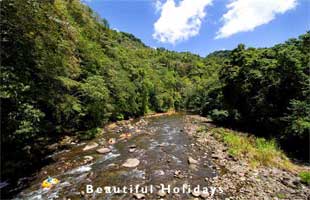Dominica Holidays Guide
The Caribbean

The "Nature Island" of Dominica (Domin-eek-ah) is home to10 of the20 active volcanoes in the Eastern Caribbeanand is theyoungest island in the Lesser Antilles. Just 739km², it is located between Guadeloupe and Martinique and is an honest-to-goodness paradise in formation; although none of the volcanoes on the island have been active in more than 1,000 years, the constant geothermal-volcanic activity from the ocean floor has created a magical variety of bubbling sulfur springs, fumaroles, solfataras, and the second largest boiling lake in the world (61 metres wide). Dominica, named one of the Top 20 Trips for 2011 by the editors of National Geographic Traveler, is perhaps one of the last remaining spots on Earth where nature is still in charge and the environment is stilla work-in-progress.

Map of Dominica
Dominica Holidays Planner
If you're looking for soft sandy beaches, fun in the sun, crowds of boisterous tourists, and miles of shopping opportunities, stay away from Dominica. This place is an eco-friendly, nature-lover's dream-come-true. But you have to be in fairly good shape to explore it all—it's almost all mountains and rain-forests,with a few isolated black-sand beaches in the northeast. The very adventurous should definitely try Canyoneering Tour, where you will rappel down virgin waterfalls, traverse deep gorges, and investigate volcanic bedrock canyons until you reach Boiling Lake, wherethe vapor-covered expansegets up to 92º Celsius.
Non-hikers who still want to see it all can ride on the Rainforest Aerial Tram, where a 70-minute trip takes you up into the treetop canopy. Other activity options include mountain biking, horseback riding, river tubing, and jeeping through the island, plus fantastical snorkeling and diving among the underwater volcanic outcroppings.

Dominica-Waterfall
The waters around Dominica are home to some 22 species of whales and dolphins, and one group of sperm whales live in this area year round. Other cetaceans that live here include spinner dolphins, pantropical spotted dolphins and bottlenose dolphins. Less commonly seen animals include killer whales, false killer whales, pygmy sperm whales, dwarf sperm whales, Risso's dolphins, common dolphins, Atlantic spotted dolphins, humpback whales and Bryde's whales.

Dominica-Roseau
Dominica Accommodation Guide
Although the island sounds like it has no room for civilization amongst the brightly colored sulfur springs, mini-geysers, and bubbling mud pools, and it is vulnerable to hurricanes, there are amenities for visitors.There are two primary population centres: Roseau and Portsmouth; Dominica is also the home to about 2200 Caribs, the only pre-Columbian population remaining in the eastern Caribbean.If you're lucky you may come across Kalinago Indians carvingout the trunk of a Gommier tree to make a canoe. While Dominican chefs are skilled at creating European and American dishes with or without a West Indian touch, local restaurantsserve predominantly native Creole cuisine; mountain chicken (frog legs) is the national dish.There is a selection of small accommodations available, and for a truly unique 'Tarzan-like' experience, stay at the Jungle Bay Resort & Spa,a 22-hectare tropical retreat with 35 isolatedcottages suspended high on tall(sturdy) posts just under the jungle canopy.

Dominica-Layou River Tubing